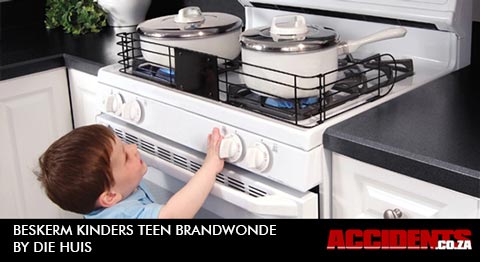Beskerm kinders teen brandwonde by die huis
29
May
Ons het onlangs op die Blog Accidents.co.za meer inligting verskaf rakende die beskerming teen brandwonde en wil ook graag hier daaraan aandag verleen. Dit is uiters belangrik dat ons veral ons kinders beskerm teen brandwonde by die huis. Met die hulp van CrisisOnCall verskaf ons graag die volgende inligting:
BRANDWONDE BY DIE HUIS
‘n Algemene ongeluk wat tuis gebeur, is brandwonde. Die meeste ligte brandwonde herstel gewoonlik sonder om letsels te laat. Sommige rate kan egter meer skade as goed doen, wees dus baie versigtig.
Dít is wat jy moet (en nié moet) doen:
• Hou die gebrande area in koue of lou water vir 10 – 30 minute. (Moet nooit ys op ʼn brandwond sit nie – dit sal net meer skade aan die vel doen.)
• Om botter of olie op die brandwond te sit, help glad nie. Boonop kan jy jou vel braai!
• Verwyder klere of juwele naby aan die brandwond, maar moenie materiaal probeer verwyder wat aan die wond vassit nie. Jy sal die vel net verder beskadig.
• Moenie blase bars wat op die vel vorm nie. Die vel maak juis blase om ʼn beskermende lagie te skep.
Elektriese of chemiese brandwonde lyk nie altyd ernstig nie, maar enige brandwond is potensieel gevaarlik. Gaan so gou as moontlik na die naaste hospitaal met ʼn ongevalle-eenheid.
BRANDWOND KATEGORIEË
Brandwonde word in vier kategorieë geplaas:
• Eerstegraad: Vel sal net rooierig, soepel en ietwat geswel wees. Die wond sal toe, maar baie pynlik wees.
• Tweedegraad: Daar sal blase wees en die wond sal ook baie pynlik wees. Afhangende van die diepte van die wond onder die blaas sal dit baie rooi tot lig pienk wees. Die wond sal steeds soepel wees.
• Derdegraad: Hierdie wond sal baie pynlik wees en leeragtig voel. Die vel by die wond sal wit of roomkleurig wees. Spontane herstel is nie meer ʼn opsie nie.
• Vierdegraad: Hierdie wonde kan dieselfde as derdegraadse brandwonde lyk, maar in baie gevalle is die wond swart as gevolg van die brand. Dit is nie net die vel wat gebrand het nie, maar die
onderliggende weefsel ook. Derde- en vierdegraadse brandwonde sal nie self herstel nie en moet chirurgies met, onder andere, veloorplantings, reggestel word.
Hiermee ook die inligting in Engels vanaf Accidents.co.za:
Did you know?
- A scald is a burn from hot liquid or steam.
- Every day, 352 children ages 19 and under are injured as a result of a fire or burn-related cause.
- Among children under 5 years of age, scalds or contact burns are responsible for 90 percent of burn injuries.
- Children have thinner skin than adults which can result in a more severe burn.
- The most common places children experience scalds are in the kitchen or dining rooms and in the bathrooms.
- The maximum recommended residential water temperature is 120˚F (48˚C).
It is important to remember that children, especially those ages 4 and under, may not perceive danger, have less control of their environment, may lack the ability to escape a life-threatening burn situation and may not be able to tolerate the physical stress of a burn injury.
Since burns are recognized as one of the most painful and devastating injuries a person can sustain and survive, we want to arm you with the tools to keep your children safe from this devastating injury. Here are a few tips that will help.
Top tips to keep your kids safe around the house.
KITCHEN AND HOT FOOD
- Keep children at least 3 feet from hot appliances, pots, pans or food.
- Use spill-resistant mugs when drinking hot liquids around children.
- Avoid using tablecloths or anything a child can pull on and cause hot food to spill.
- When cooking, use back burners and keep pot handles turned towards the back of the stove.
- Always tuck cords from appliances where children cannot reach them.
- Never hold a child when cooking something hot.
- Test and stir all food before serving children to make sure it is cool enough to eat.
- Supervise children closely when they are in or near the kitchen.
BATHROOM
- Always test the bath water with your hand before bathing children.
- When children are in or near the bath, watch them closely checking the water temperature frequently.
- If you are unable to control the temperature that comes out of your faucet, install special tub spouts or shower heads that can shut off the flow of water when it gets too hot.
How do we respond having suffered burns?
- Cool burns under RUNNING water for 10 minutes
- Never put anything other than water or specific burn dressings onto burns
- Never use any oil based ointment on burns
- Always test the heat of bath water before your child climbs in
- Educate children on the importance of fire safety
- Never leave open flames or heating equipment unattended for even a short period of time
- Do not burst blisters formed by scalds or burns
- Always wear sunscreen on exposed skin when outdoors, even in Winter
- Keep Burnshield in your home for treatment of minor burns and scalds
- Remove clothing and accessories that may retain heat on burns
Information from SAFEKIDS and ER24



